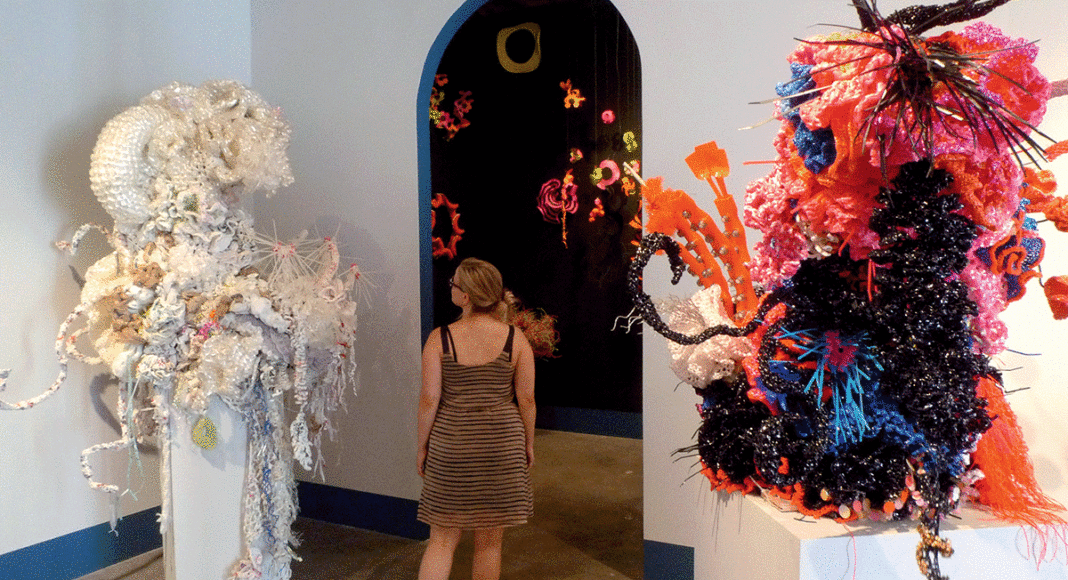Art and science—oil and water? Not really, as a bold new exhibition at the Sesnon Gallery will reveal next week.
Crochet Coral Reef is a world-wide phenomenon and a traveling exhibition, the brainchild of sisters Margaret and Christine Wertheim. An unimaginably wild and fanciful “underwater” scene made entirely out of voluminous, hand-crocheted forms, the “reef” is a curator’s dream, as Sesnon Director Shelby Graham explains: “It lives at the intersection of artists and communities, of art and science, of formal beauty and pure mathematics.”
Rarely has an exhibit this uncanny been devised to also focus attention on the environmental crisis of oceanic pollution, the sort of pollution that is causing the die-off of the world’s magnificent coral reefs as well as other aquatic ecosystems.
“The upcoming exhibit explains the world in ways that people can see and understand,” Graham adds. “Coral reefs are decaying and pitting due to acidification of ocean water, as well as climate change.”
The sisters Wertheim—one a science writer, the other on the faculty of California Institute of the Arts—hit upon their opulent idea for a traveling crochet show after discovering the work of Cornell University mathematician Daina Taimina. Taimina utilized crochet techniques to create physical representations of hyperbolic (i.e. non-Euclidean) volumes, which curve space outward, rather than along flat planes, or inward as spherical shapes. Much like fractals (a mathematical set that has a repeating pattern at every scale, such as the Mandelbrot Set), these forms come into being through a small set of steps repeated again and again and again, a sort of an artisanal algorithm.
The installations are breathtaking. “The front gallery has all deep blue walls,” says Graham. “And the main gallery space is bright red.” All the better to show off the dazzling array of bioforms crocheted into underwater worlds.
Display cases will be filled with the curated masterworks that arrive in Santa Cruz in time for the Feb. 10 exhibit opening, fresh from their residency in New York City. “The back gallery will be completely darkened,” Graham says. “Visitors will use flashlights to illuminate the White Coral Reef installed along the walls. Very deep-sea diving.”
Hanging high above will be a massive collection of plastic trash collected by the sisters over a four-year period, and providing shocking evidence of the persistence of plastic use—and waste—in the first world.
Feminist show and tell? Perhaps, since crochet is one of the most ancient, and yes, female-centric, hand arts.
The Wertheims also invite aspiring crochet-artists along the traveling exhibit’s route to stitch up their own crochet circle partnerships in the form of community coral reefs, to be considered for an upcoming show at the Seymour Marine Discovery Center.
The climax of the upcoming show will be the opening of the UCSC Satellite Reef exhibit in May 2017, at the Seymour Marine Discovery Center. A community-crocheted “reef” is being made as you read this by 400 community and student hand crafters. Kelp gardens, wooly-headed anemones, and crenelated and curlicued corals, are all being shaped toward the May show. “We want people to see how a crocheted form makes tangible, complex mathematical theory, and also bring awareness of issues confronting the ocean,” Graham says. “The crochet circles help a conversation begin—and continue.”
Info: Crocheted pieces for the Seymour Reef show can be dropped off either at the Sesnon Gallery or at the Institute of the Arts & Sciences in the DARC building at UCSC. To hear how the aquatic crochet-a-thon began, join Christine Wertheim at DARC 108 on 4 p.m., Friday, Feb. 10 for an artist talk, followed by a reception from 5-7 p.m. at the Sesnon Gallery. art.ucsc.edu/galleries/sesnon/current.













